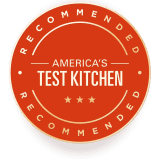The Best Chef’s Knives for $75 or Less
Equipment Review
Serrated knives are great for cutting so much more than bread. Which one is best?
Published Aug. 17, 2022.

Our favorite serrated knife is the Mercer Culinary M23210 Millennia 10-Inch Wide Wavy Edge Bread Knife, and it has been for many years. It has a long, relatively tall, sharp blade with few but deep serrations that provide great power and slicing ability. And its large, grippy handle is comfortable for hands of all sizes to hold.
A good serrated knife is a kitchen essential—one of the three basic knives we think every home cook should have (along with a chef’s knife and a paring knife). It’s sometimes called a bread knife, but its uses extend far beyond slicing loaves. As we explained when we reviewed these tools previously, the point (pun intended) of using a serrated blade is to cut into foods that are too hard or squishy for straight blades (such as the one on a chef’s knife) to get a purchase on. The points sink into the food while the scooped-out gullies between them reduce the blade’s friction as it moves through the food. Less friction makes it easier for the user to saw back and forth and cut through the food cleanly.
This means that serrated knives excel at cutting not only rustic bread loaves but also thick-rinded watermelons, tough-skinned pineapples, and delicate foods such as layer cakes or squishy tomatoes. They’re also useful for cutting foods with layers of different textures, such as sandwiches or baked goods.
There are two basic kinds of serrated knives. “All-purpose” serrated knives have blades that extend straight out from the handle, whereas “offset” serrated knives have blades that drop down at a 90-degree angle from the handle before extending straight outward. We reviewed both types of knives, all with stainless-steel blades between 9 and 11 inches in length.

The mission of America’s Test Kitchen Reviews is to find the best equipment and ingredients for the home cook through rigorous, hands-on testing. We stand behind our winners so much that we even put our seal of approval on them.

Miye is a senior editor for ATK Reviews. She covers booze, blades, and gadgets of questionable value.

This is a members' feature.